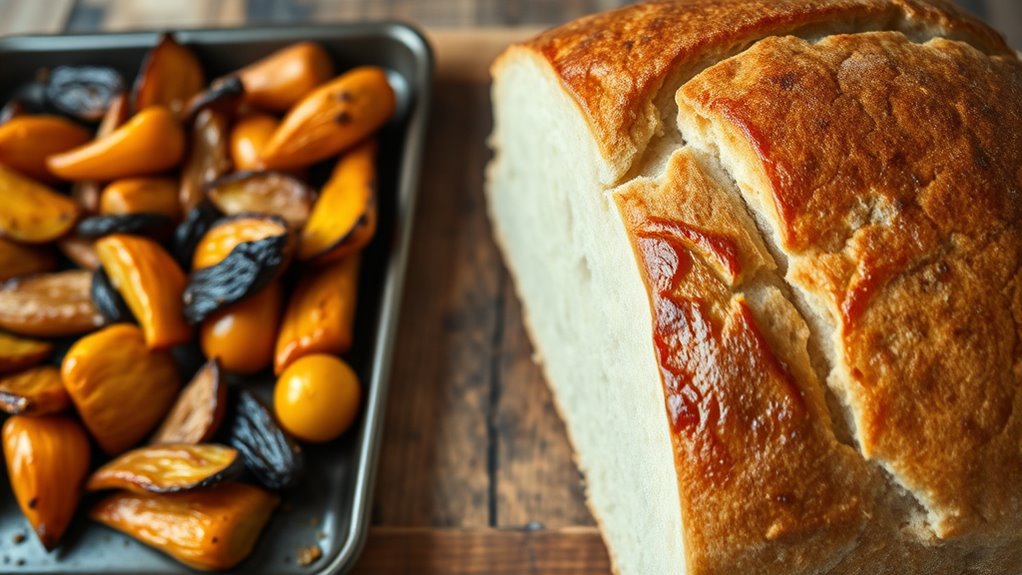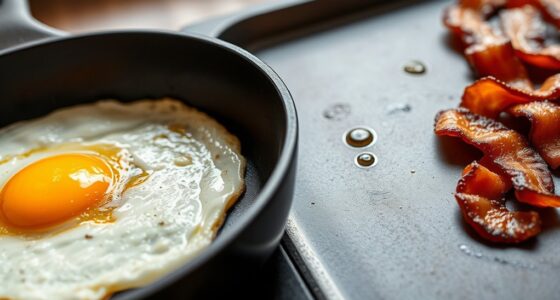Roasting and baking both use dry heat, but they serve different purposes. Roasting involves higher temperatures and is ideal for browning, caramelizing, and developing rich, flavorful crusts on foods like meats and vegetables. Baking generally uses moderate heat to cook delicate items such as bread, cakes, and pastries evenly without charring. Understanding these subtle differences helps you choose the right technique for perfect results—continue to explore to master each method.
Key Takeaways
- Roasting uses higher temperatures for browning and crispiness, while baking employs moderate heat for gentle, even cooking.
- Roasting enhances savory flavors and develops a caramelized crust; baking emphasizes texture and sweetness in baked goods.
- Roasting benefits from bold seasonings and marinades, whereas baking favors delicate seasonings to complement the dough or batter.
- Roasting typically uses sturdy cookware like cast iron or stainless steel, while baking relies on lighter materials such as glass or aluminum.
- The final results of roasting are crispy, flavorful exteriors; baking yields tender, evenly textured baked items.

When it comes to cooking, understanding the differences between roasting and baking can help you achieve better results in the kitchen. While they both involve dry heat and often use similar temperatures, their techniques, purposes, and outcomes differ considerably. One key aspect to contemplate is seasoning differences. Roasting usually enhances natural flavors and can benefit from bold seasonings, herbs, and marinades that develop a rich, caramelized crust. Baking, on the other hand, often requires more delicate seasoning to complement baked goods like bread, cakes, or pastries, where the focus is on texture and sweetness rather than a browned exterior.
Your choice of cookware also plays an essential role in each technique. For roasting, you’ll want sturdy, oven-safe pans or roasting dishes made from materials like cast iron, stainless steel, or heavy-duty ceramic. These materials conduct heat evenly and can withstand higher temperatures, ensuring that your food roasts uniformly and develops a crispy exterior. Roasting often involves higher heat settings, so your cookware must be durable enough to handle these conditions without warping or degrading.
When baking, lighter and more specialized bakeware is typically preferable. Glass, aluminum, and non-stick pans are common choices because they promote even heat distribution at lower temperatures. Baking usually occurs at moderate to low heat, aiming for gentle, consistent cooking that allows doughs and batters to rise and develop structure. Using the right cookware can influence the final texture and appearance of your baked goods, making it essential to select the appropriate materials for each recipe. Additionally, understanding temperature control is crucial, as it directly impacts the browning, texture, and overall success of your culinary creations.
Frequently Asked Questions
Can You Roast and Bake the Same Foods Interchangeably?
You can often roast and bake the same foods interchangeably, but it depends on your cooking vessel and desired flavor development. Roasting usually involves higher heat, which enhances flavor through caramelization and browning, while baking uses moderate heat for even cooking. If you want a richer flavor, roasting is ideal, but for gentle, even results, baking works well. Adjust your oven temperature accordingly to achieve the best outcome.
Which Method Preserves More Nutrients, Roasting or Baking?
You’ll find that baking generally preserves more nutrients compared to roasting because it involves lower temperatures and longer cooking times, reducing nutrient loss. Roasting’s higher heat can degrade some vitamins, especially water-soluble ones. If your goal is ideal food preservation and nutrient retention, baking is the better choice. It helps maintain the overall quality of your foods while still providing delicious results.
How Does Oven Type Affect Roasting Versus Baking Results?
Think of your oven as a trusted partner guiding your culinary journey. The type of oven, whether convection or conventional, influences roasting and baking outcomes through insulation and airflow dynamics. A well-insulated oven retains heat better, ensuring even cooking, while ideal airflow enhances browning and texture. Your choice of oven impacts how heat circulates, shaping the final result—crisp, tender, or evenly cooked—making your dishes truly shine.
Are There Specific Temperature Ranges for Roasting Versus Baking?
You should aim for specific temperature ranges to distinguish roasting from baking. Roasting typically occurs between 375°F and 450°F, requiring precise heat control to achieve browning and caramelization. Baking usually happens at lower temperatures, around 300°F to 375°F, where even heat guarantees thorough cooking without excessive browning. Adjust your oven’s temperature thresholds based on your desired outcome, and always monitor heat control to perfect your dishes.
How Does the Use of Oils Differ Between Roasting and Baking?
Did you know that about 80% of home cooks use oil in roasting, compared to only 50% in baking? When you apply oil, it enhances flavor and promotes even browning. In roasting, you typically use more oil to create a crispy exterior and deepen flavors, while in baking, oil is used more sparingly for moisture and texture. So, your oil application considerably influences the dish’s overall taste and appearance.
Conclusion
Now that you know the difference between roasting and baking, you’ll see which technique suits your dish best. Remember, it’s not always a one-size-fits-all—sometimes, you’ve got to think outside the box. Whether you’re roasting vegetables to bring out their flavor or baking a cake to satisfy a sweet tooth, trust your instincts. After all, the proof is in the pudding, so don’t be afraid to experiment and find what works for you.









